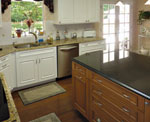
This kitchen, remodeled by Home Sweet Accessible Home, includes such universal design features as 48-inch clearance between the island and the main countertops, accessible cabinets and full-extension drawers.
Boomers Prep for the Future
More than 70 million Americans are age 55 or older — and there’ll be 85 million by 2014. But aging boomers aren’t about to let the challenges of aging force them out of their homes. Instead, they want to maintain their independence by creating environments that are accessible, safe and barrier-free, says Carolyn Sithong, an occupational therapist and Certified Aging-in-Place Specialist.
To help, local building professionals increasingly are embracing the concepts of “universal design” and “aging-in-place.” The terms are sometimes used interchangeably, but there are nuances of difference. Universal design is about creating products and environments that are usable for everyone, including the very old, the very young and people of all ages with mobility issues, says Jacksonville contractor Scott Ross. Aging in place simply means being able to live in your home safely, independently and comfortably as years pass and needs change.
The goal for both disciplines is to create aesthetically pleasing, barrier-free environments that account for all disabilities that currently exist within a household as well as others that may show up later in life.
For example, homes can be designed to provide ease of mobility and access for a person who is physically challenged and/or in a wheelchair. Features such as main-level master suites, wide doorways and curbless showers, for example, can make a home safer and more accessible. Ross’ company, Home Sweet Accessible Home, specializes in creating spaces for individuals challenged by aging, permanent disabilities or temporary handicaps.
“We do universal design, which is seamless design for all ages and abilities,” Ross says. “We do kitchen remodeling, bath accessibility remodeling, ramps and wheelchair lifts, walk-in bathtubs and strategic grab bar installation. We do shower renovations where we get rid of the curb and we also work with folks who have disabilities.”
The demand for universal design is expected to increase as the population ages, says Jacksonville remodeler Larry Murr, who also is a Certified Aging-in- Place Specialist. “What’s being projected is that more people will be staying in their present homes, which will contribute to more of the aging in-place or universal design approach,” says Murr. “Plus, remodeling in general is expected to pick up quicker than new housing once people begin to feel more comfortable with the economy.”
As homeowners contemplate their remodeling projects, Murr adds, it’s a smart move to incorporate aging-in-place and universal design features and ideas into the plan – even if you’re young and healthy. Likewise, many households are expected to be multigenerational, which means they’ll have occupants of all ages under the same roof and will need to be modified to meet everyone’s needs. Consequently, the National Association of Homebuilders (NAHB), in conjunction with the AARP, created the Aging-in-Place Specialist (CAPS) certification, which identifies professionals qualified to make aging-in-place modifications. The program has been designed to ensure that graduates receive training in construction techniques as well as instruction on how to work with the aging and mobility-challenged population. Some local remodelers, such as Frank Rodgers at Finial Builders, have been CAPS-certified. And the Jacksonville remodeling company Sport Nobles Construction has three CAPS-certified staff members.
A CAPS specialist is taught how to assess a person’s specific needs and make recommendations. Sometimes the builder works with an occupational therapist or health care professional to find the best solutions for an individual or family.
Professional consultants can make recommendations based on medical needs and priorities, Sithong says. It’s not always necessary or even feasible to rehab an entire house. Sometimes, she notes, you can focus on making important spaces such as the entry, kitchen and bathrooms more accessible.
In the bathroom, a zero-step entry works equally well for a mother with a baby stroller and an 80-yearold with a walker. Grab bars in a bathroom are great for the elderly but they’re also handy for a pregnant woman or for someone recovering from surgery.
Bathrooms should also have ample space for maneuvering in a wheelchair. A roll-in shower equipped with a fold-up bench can work well, too. A universally designed home will include many user-friendly details, such as kitchen cabinets with adjustable shelving, open floorplans, wide hallways,wide doors and at least one wide entry.
The kitchen also can be designed for easier navigation and access with such elements as microwave and refrigerator drawers, pull-out shelves and a lowered sink or prep counter with space underneath to accommodate a wheelchair.
Further, it makes sense to lower thermostats, electrical switches, closet shelves and front-door peepholes to place them within reach of everyone. Appliances can be raised off the floor for easy access. Adequate indoor and outdoor lighting is important – especially for the visually impaired. Strobe smoke detectors can be installed for the hearing-impaired.
Creating additions or installing an elevator can be a solution for some homeowners, but many modifications are easier and less expensive. For example, just switching out door hinges will allow a door to open wider and installing a spring-loaded threshold will make entry into a room easier for people using walkers and wheelchairs, Ross says.
Although remodelers try to disguise unattractive aging-in-place features, some design elements can make a home more functional and appealing, says Murr. Some elements, such as wide hallways and no-threshold entries, can also be great for resale.
Small alterations can also serve a dual purpose. Adding a decorative tile border on the floor in front of kitchen cabinets or at stairs helps residents who have problems with depth perception – and adds flair.
